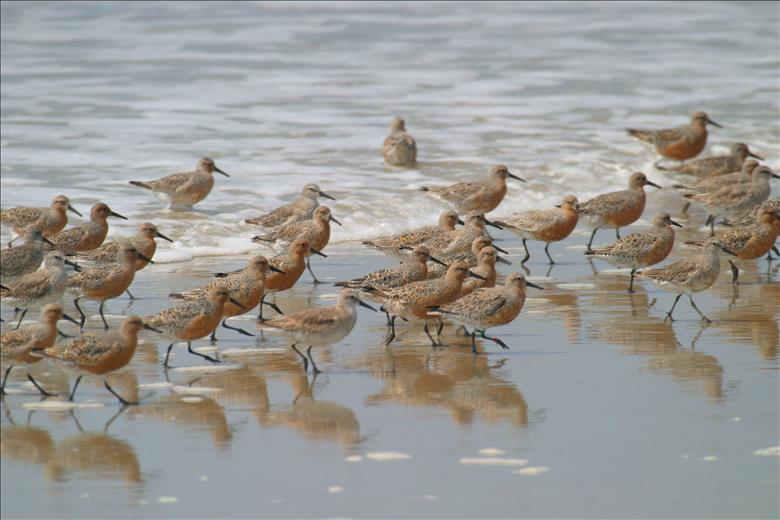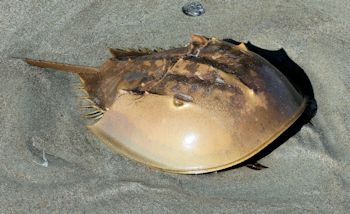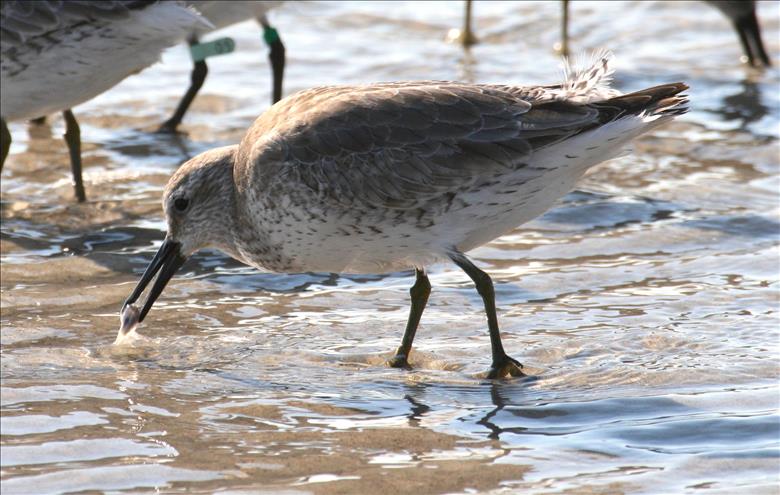Last of two parts
HAMMOCKS BEACH–One day during the late 1980s, I was maneuvering a rusty four-wheel drive pickup truck along the wide flat hard packed sandy beach strand of Bear Island at Hammocks Beach State Park. As park superintendent, I had arranged for a local ornithologist to help me scour the island for any unusual or rare bird species that I could add to the park’s natural history records as well as to provide me with some bragging rights among my wildlife-loving ranger friends.
Supporter Spotlight
I don’t remember finding any birds that would make a “life-listing bird watcher” fog up their binoculars on that day, but I do remember a casual comment made by my expert avian observing companion. As we traveled the entire length of the island, we encountered hundreds of a particular species in a number of tightly packed groups feeding at the edge of the shore as small waves gently rolled upon the beach.
 A flock of red knots feeds along the shoreline of Bear Island. Photo: Sam Bland |
This caused my colleague to announce, “I’d forgotten what a knotty beach Bear Island is.”
He wasn’t referring to the actual physical surface of the beach as bumpy; rather, it was an observation about how crowded the beach was with red knots.
Red knots are a chunky shorebird with a limited neck and stout dark bill that we frequently see racing up and down the slope of the beach as they try to forage without being tumbled feet over feathers by the incoming waves. Their name even refers to a Scandinavian king that ordered the tide to halt to spare his feet from getting wet. The birds represent the king as they run away from the waves to keep their feet dry.
Their breeding plumage is an unmistakable muted red color that covers the breast and washes up their neck and to the eyes. As one of our biggest sandpipers, this bird is found along our beaches in the spring as they journey north for breeding season and then again in the fall as they return to their wintering grounds. To casually mention that these birds migrate without further disclosure would just be irresponsible. These animals have one of the most arduous annual treks of any animal.
Supporter Spotlight
Red knot chicks start their life when they crack out of the warmth of an incubated shell and step out into the shockingly chilly air of the high Arctic Canadian tundra. By the next day, the downy chicks have ventured away from the nest and are jabbing their bill into the ground searching for insects in the wetland sedges. Within a few weeks, the chicks will be able to fly and they will instinctually rely on an internal navigation system that will take them on a 9,000-mile journey to Tierra del Fuego, the southernmost point of South America.
Here, the red knots, now with light gray plumage, will spend the winter gorging on tiny clams to pack on a full layer of thick belly fat that will provide them with enough energy to start their spring migration.
But it will take more than just fat reserves for these birds to reach the breeding grounds healthy enough to raise new chicks. Before they depart, their bodies will take on a number of physical changes. Since they will be flying for thousands of miles non-stop, their heart and flight muscles will bulk up to handle to demand. Their leg muscles will atrophy a bit since they are unnecessary while flying. Even their digestive organs, especially the gizzard, will decrease in size.
Red knot populations have six subspecies, with the rufa breed occurring along the eastern coast of North America during the spring migration. It is thought that the group, roselaari, which migrates to the west coast, can also be found on our beaches during the winter.
Each spring, unknown urges will launch a lone red knot off of a mud flat in South America. As it rises into the sky and starts heading north, thousands will join in and the migration is on. The rufa birds will head out in March destined for their major rest stop along the Delaware Bay. But first, they must fly non-stop from northern Brazil across the Atlantic Ocean to reach to the bay. When they arrive in May, they are weary, hungry and looking to replenish the fuel that they have exhausted. Nature has a way of providing. Along the intertidal zone, the horseshoe crab, an ancient-relic-looking arthropod, crawls out of the coastal waters and lays millions of tiny plump energy-packed green eggs. The red knots have timed their arrival to synchronize with the spawning activity of these life sustaining creatures. Almost all of the rufa red knots will stop in at Delaware Bay to load up on the eggs. This last pit stop is vital before the birds make the final push to the Arctic. By June, they are ready to forge ahead and complete this epic journey. If they are lucky, they will have packed on enough bulk to double their body weight, ensuring that they arrive at the mating site with enough fat to sustain them in case food sources are not yet available due to the still-frozen conditions. They must arrive strong and healthy enough to reproduce.
Simply stated, without the horseshoe crab eggs, the red knot cannot survive.
 Horseshoe crab eggs form a vital part of migrating red knots’ diets. Photo: Sam Bland |
Once at the breeding grounds, the male will select a nesting site near wetlands which will provide a convenient source of food for the adults and chicks. After creating a nest of dead leaves and lichens in open areas void of snow, the female will deposit four eggs that are stained olive with brown markings. Both the male and female will incubate the nest and three weeks later the chicks will escape their oval enclosure. After the chicks are active, the female will take off, leaving rearing duties to the male.
During the return trip south, the horseshoe crab eggs are no longer available and the knots must adjust to another food source. Along the beach swash zone, coquina clams are pre-packaged almond-sized containers of food. Probing with their bill, which is studded with nerve endings called Herbst corpuscles, they can detect the location of the colorful clams, which are then swallowed whole. Their gizzard, which has now reverted back to its normal size, is powerful enough to crush the shell and expose the nourishing meat.
 |
Scientists have long marveled at the mystery of the red knot migration, igniting intrigue into the discovery of their secrets. For the past three decades, researchers have been capturing and banding red knots to learn more about their biology. Technology has provided new ways to track the birds using light-sensitive geolocators, which reveal astounding statistics about their migration. One bird flew, non-stop for 5,000 miles over a six-day period– talk about frequent flyer miles!
Researchers also discovered that the migrating birds will divert around looming dark storms to avoid getting buffeted by strong winds as they return south. Most importantly, the locators identified the crucial habitat areas where the birds rest and refuel. Protecting, preserving and limiting human disturbance in these areas is critical to their survival. Even though the red knot winters and summers in some of the most remote places on earth, human activity threatens their existence. The once abundant horseshoe crab eggs are drying up due to overharvesting of the crabs, which are used as bait in eel traps.
During my years as a ranger on Bear Island, I would document red knot activity and provide it to the U.S. Department of Interior’s Bird Banding Laboratory. To provide detailed information, the birds have been banded with a variety of jewelry on their legs. They usually have a silver metal band with an identifying number, a color-coded band and a colored “flag” band with identifying letters and or numbers that can be easily seen with binoculars. Finding red knots banded with the flag was like a wildlife version of hide-and-seek. When I first started observing these birds I didn’t know to be on the lookout for a celebrity known as B95. Mention B95 and most ornithologists respond with admiration and awe.
 B95 statue in Mispillion Harbor, Delaware. Photo: Mike Dunn |
During a howling hailstorm in 1995, an Argentinian researcher clamped a band onto the leg of a red knot, and the released bird went on to become a legend. At that time, the bird was thought to be two, maybe three years old. Now close to twenty years old, the bird identified with the orange flag band “B95” showed up on the shores of Delaware Bay in May 2013. These birds live six to seven years tops, yet B95 continues to defy the odds. How many times did it avoid getting snatched out of the air like a bolt of lightning by the talons of a merlin? How many times did it burn up precious energy diverting around threatening storms? How many times did it burst into the air just out of the reach of the sharp teeth of an arctic fox?
Over the years, researchers, biologists and average bird watchers have put on a vigil for the arrival of a red knot with an orange B95 band, and then celebrate like they have seen Big Foot when its number comes into clear focus through the lens of a spotting scope. Only B95 is for real, and is the subject of a great book, Moonbird: A Year on the Wind with the Great Survivor B95, by Phillip Hoose. Since the sterile scientific name B95 just doesn’t play well in the press, B95 also goes by the romantic name Moonbird. Due to its longevity, B95 has flown so many miles that it could have flown to the moon and almost all the way back. This 4-6-ounce puff of feathers is an endurance athlete, and is, as they say, one tough bird.
This small bird has caused quite a stir, to which it is quite oblivious. Its international fame has been used as a teaching tool to countless school children. B95 has even been given the designation as a “Natural Ambassador” by the Tierra del Fuego Province to foster preservation, care and respect for the environment.
Sadly, during its life, Moonbird has seen the migrating flock shrink by eighty percent.
Amazingly, B95 was spotted on August 2, 2013 at the mouth of the St. Lawrence River in Canada heading its way south after another breeding season.
One day the bird watchers will not spot B95 along the Delaware Bay. “Maybe we just missed him this year”, they will say, hopeful that the bird is still alive. They will sweep their binoculars and spotting scopes through the hundreds of red knots feeding on the horseshoe crab eggs, scouring to find B95. Their pulse will race with anticipation as they spot an orange band flag that starts with the letter B, but then lower their binoculars in resignation. For a while, the online birding forums will list rumors of a possible sighting, like Elvis: Maybe B95 lives. I wish Moonbird could live forever as a symbol of the wonders of nature, but most of all as a symbol of hope that horseshoe crabs will thrive and that red knot habitat will be preserved so that a new Moonbird can carry on the legacy of B95.







